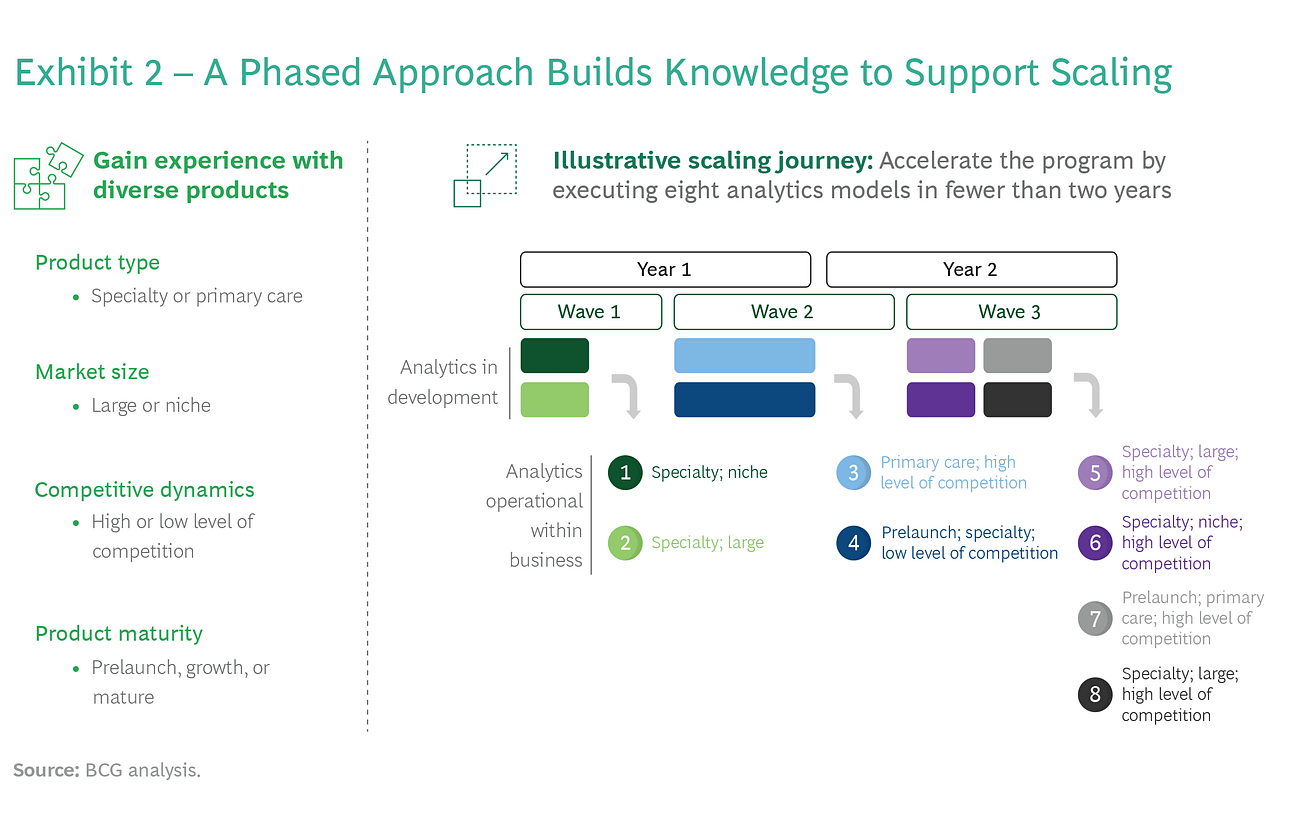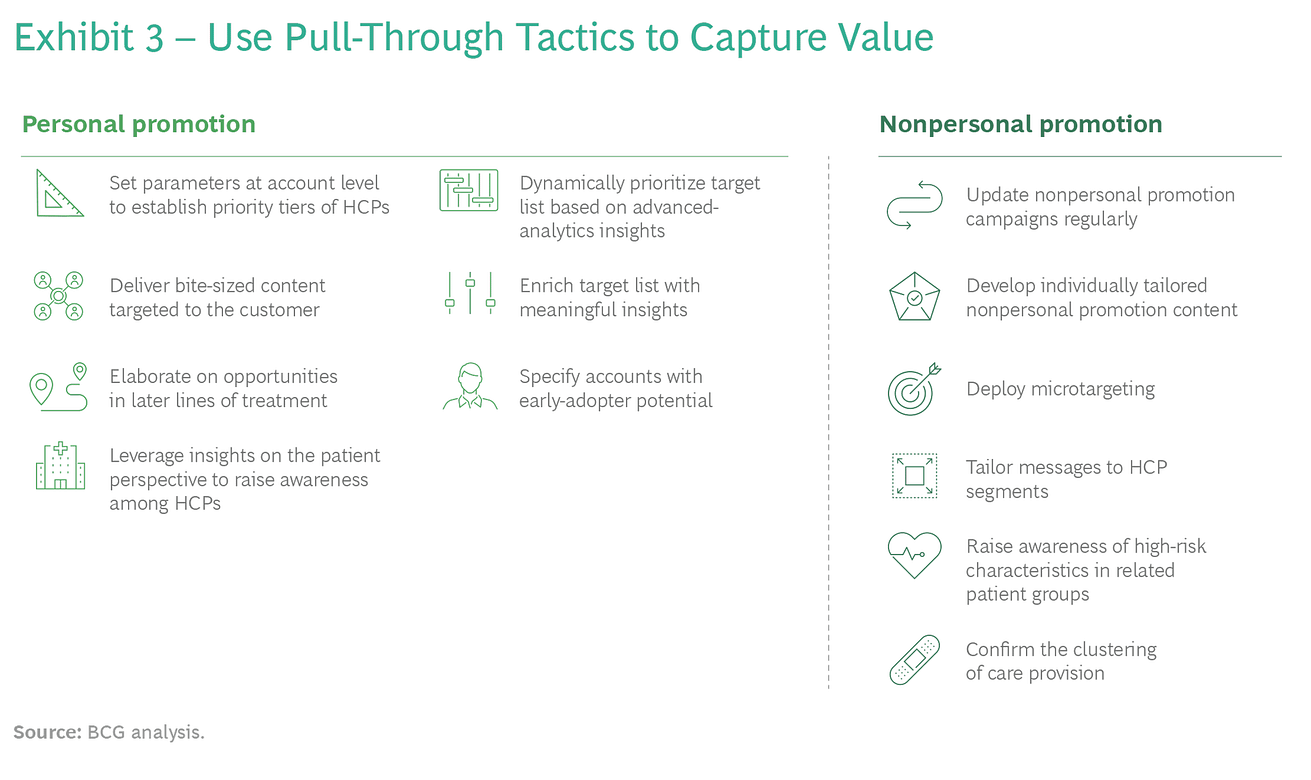05 AUGUST 2022
By Johanna Benesty, Mark Brenckle, Mathias Blom, Paul-Alexis Kebabtchieff, Troy Mullane, and Youmna Saloumi
Executive Summary by:
Joaquim Cardoso MSc.
In recent years, biopharma companies have tested the use of next-generation analytics in identifying the best points along the patient journey to reach health care providers (HCPs).
- Although many of these studies have produced valuable insights, few companies have put those insights into action or scaled beyond one-off pilots.
To use analytics to get the right therapies to the right patients, companies must continuously apply data-driven insights at scale across the product portfolio.
- Successful companies think big, start small, and scale fast.
- They articulate a bold vision for deploying analytics to understand patient care trajectories, and they initiate the program with small pilots that build capabilities while demonstrating value.
- To quickly achieve scale, they define clear plans for staffing and pilot selection and ensure strong engagement by teams that will apply the insights in their communications with HCPs.
- Finally, these teams capitalize on the insights by delivering appropriate messages to the right HCPs at the right time.
Outline of the publication:
- Think Big, Start Small, and Scale Fast
- Set a Broad Vision and Gain Experience
- Build Capabilities While Delivering Initial Results
- Ensure that End Users Own the Solutions
- Put the Insights into Action
Selected images:



Conclusion
- Biopharma companies have tremendous opportunities to use next-generation analytics to map patient journeys and address patients’ unmet needs for medicines. Pilots have demonstrated the value.
- Now is the time for companies to articulate and execute a bold vision for patient journey analytics as a fully scaled, continuously applied internal capability.
- The transition will require careful planning, new skills, rigorous stakeholder engagement, and a commitment to putting insights into action.
- From a societal perspective, the payoff is clear: identifying where treatments can be used most appropriately to achieve the best clinical outcomes.
ORIGINAL PUBLICATION (full version)

Think Big, Start Small, and Scale Fast
Biopharma companies have always striven to commercialize their products more efficiently. This includes giving relevant and truthful information about a product’s value proposition to HCPs so that they can better evaluate it in their clinical decision making. To reach the right decision makers, companies traditionally used historical prescribing patterns from syndicated data to identify which HCPs treated patients for a disease and at which stage. Companies hoped that patients needing their therapies in the future would be treated by the same HCPs who were included in those historical data sets. But because this was not always the case, companies struggled to reach key decision makers at the right time.
About five years ago, biopharma companies started experimenting with applying analytics and artificial intelligence to data from insurance claims and electronic health records to better understand patients’ care trajectories. As analytics capabilities evolved, companies began to develop more sophisticated ways of identifying patients with the greatest unmet needs.
For example, a biopharma company used an analytics model to identify patients who could benefit from a new oncology drug. Among other insights, the company discovered that certain oncologists did not adhere to the most up-to-date treatment paradigm. To expand patients’ access to the new drug, the company targeted these oncologists with a message describing the latest treatment guidelines. The company also developed internal capabilities that allowed it to deploy the same methodology in a pilot relating to another product several years later.
Although such pilots generate value and build skills, biopharma companies have a much bigger opportunity to transform their commercialization models. Instead of applying analytics capabilities in one-off studies to uncover insights about a specific product, companies can use an industrialized platform to leverage those capabilities across their brands systematically and continuously. This means that each pilot is no longer just an isolated event, with the next study happening years later. Rather, it is one step on an ongoing journey that begins with a comprehensive vision and uses a series of strategically selected pilots to build internal capabilities and rapidly replicate impact throughout the portfolio.

Set a Broad Vision and Gain Experience
A comprehensive vision sets the broader ambition for applying analytics, and each pilot builds capabilities that contribute to achieving the ambition.
Articulate a vision. When the objective is merely to answer a specific question, the result will be a dead-end pilot. Instead, the company should articulate how it will apply analytics to solve problems routinely. Such a vision might be: “Within two years, all our brands will have internal capabilities to apply data-driven insights at scale to continuously improve marketing and customer segmentation.”
Conduct pilots to learn and evolve. Using a test-and-learn approach in pilots allows the organization to gain knowledge and skills that help improve subsequent pilots. Over time, pilots become more efficient, entail fewer risks, and gain support from key stakeholders.
Pilots provide opportunities to train and engage people across the organization. Internal data scientists learn how to use an analytics methodology and build a codebase that enables them to extract insights from data. Cross-functional partners-including marketing, medical affairs, and sales-learn how they can apply the improved view of the patient journey to execute their function’s strategy. Pilots also give teams experience in using analytics responsibly. (See the sidebar, “Ensure Responsible Use.”)

Build Capabilities While Delivering Initial Results
Some biopharma companies have waited for several pilots with external vendors to succeed before starting to build internal capabilities. Reliance on external vendors is expensive and limits a company’s ability to scale up its analytics capability. By building internal capabilities early on, the organization can control how it captures competitive advantage, apply analytics broadly and rapidly, and improve efficiency.
To build internal capabilities and achieve impact, the company needs to establish two supporting pillars: an HR strategy and a portfolio strategy.
Define the operating model and recruitment plan. An HR strategy begins with a clear vision of the target operating model-that is, the degree to which analytics capabilities will be deployed centrally or located within each brand or commercial entity. (See Exhibit 1.)

To design the target operating model, the company should consider the extent of centralization in other aspects of its operations (such as strategy, investment decisions, delivery, and maintenance) and whether digital competencies are primarily available centrally or locally. It should also consider which model will allow it to design roles, responsibilities, and career paths that are attractive to those executing projects. Many data scientists seek learning and development opportunities that give them exposure to different types of projects while building expertise.
HR then needs to specify the type of skills needed across data science and business teams and define a talent acquisition plan. This includes a recruitment plan that sets out the number of new hires needed over different time frames and the skill sets required to match the organization’s ambitions.
Locating and recruiting people with relevant skill sets-such as data scientists with deep subject matter expertise and user interface designers-is often a new challenge for biopharma HR teams, which will need access to previously untapped talent networks. Once onboard, new hires need to be assigned to pilots so that experienced personnel can train them and transfer knowledge.
Design the portfolio for value creation and skill building. To select pilots, the company should consider how a project can deliver value as well as how it can contribute to building capabilities that are applicable to different products, markets, or use cases. Strategically selecting brands with different characteristics allows teams to accumulate knowledge that will support the scaling up of the analytics capability across the full portfolio of brands. (See Exhibit 2.) The company should quickly stop pilots that do not deliver the expected value-but also learn from the experience.

Ensure that End Users Own the Solutions
Developing analytics solutions is only the starting point. The organization must also be committed to maintaining, refining, and deploying these solutions as part of its regular go-to-market approach. To ensure that solutions survive beyond the development stage, teams applying insights in the field should be co-owners of analytics projects. This means participating in designing solutions so that their needs are met and committing resources-such as cofunding costs or training staff-so they have a stake in the project’s ongoing success. To enable co-ownership, the company should also put in place governance mechanisms, such as steering committees and clear decision rights.

Put the Insights into Action
To realize tangible impact, companies need to take practical steps to apply (or “pull through”) insights to key strategic areas. (See Exhibit 3.) For example, to enhance personal-promotion efforts, the company can allocate its field force according to a real-time understanding of how each HCP could improve patient outcomes. In nonpersonal promotion, it can integrate predictions about relevant HCPs’ concentration in specific areas with third-party marketing platforms to optimize channel spending. Companies need commercial metrics-such as net new conversions or increased call frequency to specific customer segments-against which to measure the success of pull-through tactics.

To account for real-world constraints and avoid having to redesign solutions, teams need to agree on pull-through tactics early with the right stakeholders. Involving stakeholders from supporting functions-such as IT, legal, procurement, and sales-enables teams to proactively resolve implementation challenges and identify dependencies.
Conclusion
Biopharma companies have tremendous opportunities to use next-generation analytics to map patient journeys and address patients’ unmet needs for medicines. Pilots have demonstrated the value.
Now is the time for companies to articulate and execute a bold vision for patient journey analytics as a fully scaled, continuously applied internal capability.
The transition will require careful planning, new skills, rigorous stakeholder engagement, and a commitment to putting insights into action.
From a societal perspective, the payoff is clear: identifying where treatments can be used most appropriately to achieve the best clinical outcomes.
From a societal perspective, the payoff is clear: identifying where treatments can be used most appropriately to achieve the best clinical outcomes.
Originally published at https://www.bcg.com on July 28, 2022












